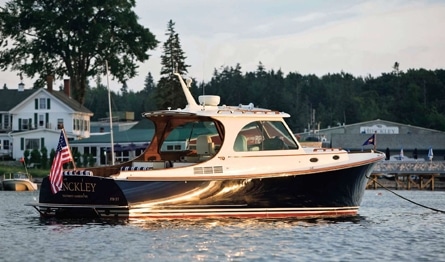
Hinckley37445.jpg
At first, I thought it was a foldout table-tiny, but nevertheless convenient to anyone who sits on the chair atop the engine box. Just as I noticed the nonskid surface, Hinckley’s Ed Roberts told me that the object of my curiosity was a boarding step, and he pointed out the one on the opposite side of the cockpit, hiding discreetly behind teak veneer. Of course. Each step lines up perfectly with the teak pad on the port and starboard wash decks, so when you step aboard from the float you don’t have to grope around for a graceful way to avoid sullying the upholstery with your dirty street shoes. That’s only one of the thoughtful details aboard the new Hinckley Picnic Boat 37-a design given the unenviable task of succeeding the original Picnic Boat, introduced in 1994.
We really can’t understand the importance of the PB37 and how her design evolved without examining the captivating characteristics of the original PB36. In that boat, designer Bruce King drew an impressionist’s interpretation of styling themes that we commonly ascribe to lobster boats and New England bass boats, and in the case of the trunk cabin, to traditional sailing yachts. Powered by a single diesel engine spinning a waterjet drive, this little yacht offered minimal accommodations beneath its lovely trunk cabin, an enticing bridge deck and cockpit, moderate speed, the foolproof dockside handling provided by the JetStick, and the cachet of being a Hinckley. The PB36 found buyers overseas, as well as in North America, and Hinckley sold hundreds of them.
The world of yachting has changed quite a lot during the 14 years the PB36 has been in production. The universe of buyers who want to spend more than $500,000 for a small day boat has shrunk, and Hinckley could no longer ignore the requests from prospective buyers for more speed and space in a package that would be as handsome and as easy to handle as the original Picnic Boat. The powers that be at Hickley listened well, and teamed up with designer Michael Peters to produce the PB37-a worthy successor to the original iteration.
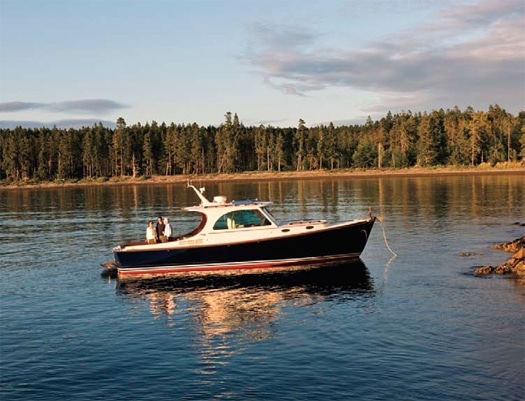
| | |
Peters earned his reputation for excellent design work from the bottom up, drawing deep-Vs and catamarans for offshore powerboat racing sanctioned by the American Power Boat Association and the Union Internationale Motonautique, the governing body of world motorboat racing. His expertise in designing race-winning bottoms, softriding deep-V hulls, and stunning production boats, attracted Hinckley to Peters. The bottom of the PB37 came from his drawing board, the styling from Hinckley. Maintaining continuity of style has determined the look of the new boat, as it should. Why argue with success?
I’ve never driven the 36-foot Picnic Boat, though I’ve sampled every other example of the Talaria line and have always come away pleased by the experience. So, I kept my expectations zipped into a compartment in my briefcase and began to look around. The PB37 immediately feels larger than her ancestor-beamier, taller, and generally more accommodating. Seated on the portside settee opposite the drop-leaf table, I had an unobstructed view of our surroundings and imagined a cozy dinner for two at sunset, the PB37 swinging gently at anchor in a shallow, and very private, cove. The interface between the world outdoors and the bridge deck becomes all the more intimate when you push a button at the helm and let the electric motors open each side window or raise the hatches in the overhead-two more details that endeared the boat to me.
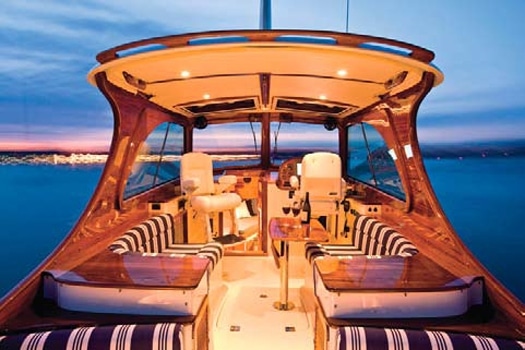
| | |
The settees are comfortable, and the drop-leaf table allows easy passage fore and aft. When you have guests aboard, you may swivel the Stidd seats to face your company. A bigger party may overflow to the cockpit, one step down from the bridge deck. On the other hand, that single step down, combined with the length of the area between the windshield and the transom, allows the folks in the cockpit to separate themselves into a little gathering of their own. As night falls on our party, the sensible might escape the chill by moving forward and displacing the others to the cockpit. The hardy would never admit to preferring the shelter, and the chilly air is a fine place to enjoy a cigar without controversy.
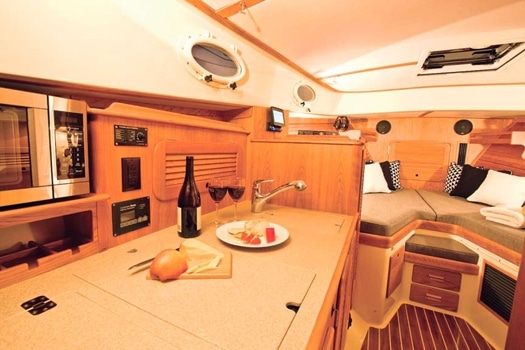
| | |
After the guests retreat to their boats or go ashore, you and your mate can snuggle into the cabin and watch the flatscreen TV, listen to music, read, or talk. If the nighttime temperature takes a dive, you can turn on the heater, although in this relatively small area, an oil lamp or two may ward off the chill. Cherry ceilings and joinery, in mattefinish varnish, will glow in the light of the lamps and make the cabin seem warmer than it is. In balmy weather, you have the option of opening the hatches over the vee-berth and the companionway for flow-through ventilation. On sweltering nights, turn on the air conditioner and sweet dreams.
Come morning, you can prepare a full-tilt breakfast on the twoburner cooktop and in the microwave oven. The top-loading refrigerator ought to hold enough provisions for a few days of cruising. Sun shining through the big side windows, a soft breeze rustling through the hatches, the smell of frying bacon and brewing coffee climbing up the companionway-life is good.
Getting to your destination will be as entertaining as your stay. The four-cylinder Volvo Penta D4s are uncommonly smooth, seeming to ignore the physical principles that make an in-line four inherently rougher than an in-line six. Their combined output of 600 horsepower accelerates the PB37 in one great thrust when you open the throttles to the stops, and the wind-up that’s characteristic of water jets seemed minimal. I clocked a cruising speed of 27 knots at 3300 rpm. Although the 37 doesn’t need trim tabs during acceleration or while she’s cruising on plane, some tab gets the bow down just enough to shatter the chop and smooth the ride. It also helps short folks see the water closer to the bow.
Jet boats like to wander a little when you steer them manually-you wouldn’t notice this while the autopilot steers, because you need the steering wheel in your hands to sense it. But the Hinckley holds a steady course and her straight tracking became apparent as I spent more time at the wheel. In spite of this new model’s increase in size and weight, she felt light on her bottom, turning quickly and accurately. On the other hand, she felt substantial, the way a larger boat feels as it slices through the water, but never cumbersome. All in all, the PB37 is the sort of boat that makes you wish the destination were farther away.
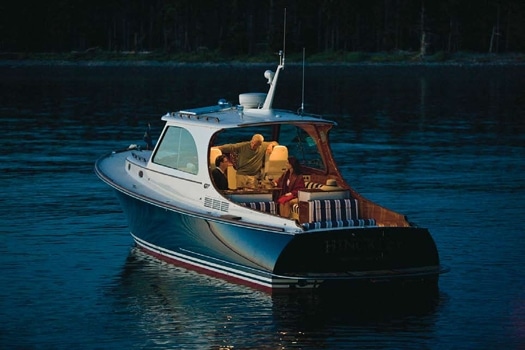
| | |
To reinforce the importance of seemingly small details, I have to say that I love the teak rail on the after edge of the coach roof. It’s within easy reach as you board the boat from the side. The teak rails along the outboard edges of the top take all the worry out of going forward. And I love the antenna mast-Hinckley’s staff designed it and it perfectly suits the boat.
Buyers of the PB37 can expect to pay more than $715,000 for a well-equipped example, but signing up for all the options raises the price a lot. However, good resale value, classic styling, high-quality construction, and great service all come standard. Hinckley delivers the boat to you and provides three days of training in the operation of the JetStick and all of the boat’s systems. That’s enough to make a proud owner smile.
Hinckley Yachts, (401) 683-7005; www.hinckleyyachts.com









